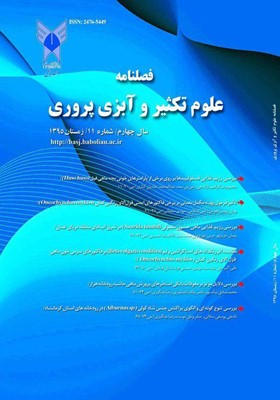تأثیر فرمول بهینه مکمل معدنی بر برخی فاکتورهای ایمنی قزلآلای رنگینکمان (Oncorhynchus mykiss)
محورهای موضوعی : علوم تکثیر و آبزی پروریپویان بهمن 1 , هومن رجبی اسلامی 2 * , مهدی سلطانی 3
1 - گروه شیلات، واحد علوم و تحقیقات، دانشگاه آزاد اسلامی، تهران، ایران
2 - گروه شیلات، واحد علوم و تحقیقات، دانشگاه آزاد اسلامی، تهران، ایران
3 - گروه شیلات، واحد علوم و تحقیقات، دانشگاه آزاد اسلامی، تهران، ایران
کلید واژه: بقا, ایمنی, مکمل معدنی, قزلآلای رنگین کمان (Oncorhynchus mykiss),
چکیده مقاله :
ارتقای سیستم ایمنی و افزایش رشد و بازماندگی ماهیان در مراحل اولیه زندگی از اصلی ترین نیازهای پرورش دهندگان می باشد. به همین منظور آزمایشی برای مشخص کردن تأثیر مکمل معدنی بر میزان بقا ماهیان و بررسی برخی از متغییرهای ایمنی ماهی قزل آلای رنگین کمان(Oncorhynchusmykiss) در مزرعه پرورش ماهی طبرستان واقع در آمل طراحی شد. این مکمل حاوی 8 ماده معدنی روی، ید، مس، کبالت، منگنز، منیزیم، سلنیوم و آهن بود. شش جیره غذایی حاوی مقادیر مختلف مکمل مواد معدنی شامل مقادیر 2، 3 و 4 درصد از مکمل معدنی تیمار 1 طراحی شد. تعداد 700 بچه ماهی با وزن ابتدایی1 ±40 گرم به 6 تیمار و 3 تکرار تقسیم شدند و تعداد 40 عدد بچه ماهی به صورت تصادفی در هر فضای آزمایشی قرار گرفتند. بچه ماهیان 12 هفته از طریق جیره های غذایی تغذیه شدند. در همه آزمایش های انجام شده تیمار شاهد دارای پایین ترین میزان در متغیرهای ایمنی ماهی بود. نتایج نشان داد که میزان بقای بچه ماهیان در همه تیمارهای آزمایشی برابر 100 درصد بوده است و هیچ اختلال ظاهری نظیر تغییر سرپوش آبششی، شنای غیرعادی همراه انحنای افقی و عمودی ستون فقرات در بچه ماهیان قزل آلای رنگین کمان در طی 12 هفته دوره پرورش مشاهده نشد. همچنین، تفاوت معنی داری بین پروتئین کل، هماتوکریت، گلبولهای سفید، گلبول های قرمز و آلبومین مشاهده شد (P<0/05). در دو نوبت نمونه برداری برخی پارامترهای خون شناسی ماهیان آنالیز شد که اختلاف معنی داری در بین دو بار نمونه برداری مشاهده نشد ولی در بین تیمارهای آزمایشی در شمارش تفریقی گلبولهای سفید و قرمز اختلاف معنی داری بین تیمارهای آزمایشی مشاهده گردید(P<0/05). همچنین بیشتر سطح ایمنی مربوط به تیمارهای 1 و U بود. نتایج این پژوهش نشان داد که میزان مواد معدنی برای بهبود شاخص های ایمنی بچه ماهیان قزل آلای رنگین کمان نسبت به جیره پیشنهادی U، یک درصد بیشتر است.
The most basic needs of fish breeders is the enhancing the immune system and increasing growth and survival of fishes in their early life stages. Therefore, an experiment was designed to determine the effect of mineral supplementary on the survival of fishes and some safety variables were investigated on rainbow trout fish (Oncorhynchs mykiss) at a fish farm located in Amol. This supplementary included 8 mineral materials the zinc, copper, cobalt, manganese, magnesium, selenium and iron. Six diets containing different amounts of mineral premixes with 2, 3 and 4% of the minerals of treatment 1 were designed. Seven hundred young fishes with initial weight 40 ± 1 g were divided into 6 treatments and 3 replications and 40 young fishes were randomly assigned to any place. Young fishes were fed the diets for 12 weeks. In all experiments, control treatment has the lowest level of the safety variable of fish. The results showed that the survival rate of young fishes in all treatments was 100% and no deformity, such as changing the gill cover, unusual swimming with horizontal and vertical curvature of the spine of rainbow trout fishes was observed during the 12 week period of culture. Also, the significant differences were observed between total protein, hematocrit, white blood cells, red blood cells and albumin (P≤0.05). Some parameters of hematology of fishes were analyzed in twice sampling. It was not observed significant differences between two times of sampling, but in treatments in the differential count of white and red blood cells were observed the significant differences (P≤0.05). Furthermore, more safety level related to treatments 1 and U. The results showed that the amount of minerals to improve safety indices of rainbow trout young fishes compared to the diet recommended U is one percent more.
_||_
Haghighi, M. (2009). Laboratory Methods of Fish Hematology. Iranian Fisheries Research OrganizationPublication. Tehran, Iran.
2. Blaxhall, P.C., Daisley, K.W. (1973). Routine hematological methods for use with fish blood .J. Fish. Biol. 5: 771-781.
3. Hazel, J. R., and Landrey, S. R. (1988a). Am. J. Physiol. 255, R622.
3. Limsuwan, T. and Lovell, R.T., (1981). Intestinal synthesis and absorption of vitamin B,, in channel catfish. J.Nutr., 111: 2125-2132.
4. Hilton, J.W. and Hodson, P.V., (1983). Effect of increased dietary carbohydrate on selenium metabolism andtoxicity in rainbow trout (Salmo gairdneri). J. Nutr., 113: 1241-1248.
5. NRC (National Research Council), (1983). Nutrient Requirements of Warmwater Fishes and Shellfishes.
6. Ogino, C., and Yang, G. Y. (1978). Bull. Jpn. Soc. Sci. Fish. 44, 1015.
7. Hilton, J. W., Hodson, P. V., and Slinger, S. J. (1980). J. Nutr. 110, 2527.
8. Desjardins, L. M. (1987). M.Sc. thesis, University of Guelph, Guelph, Canada.
9. Lovell, R. T. (1978). Trans. Am. Fish. Soc. 107, 617.
10. Hardy, R. W., Shearer, K. D., and Spinel, J. (1979). Aquaculture 38, 35–44.
11. Leary, D. F., and Lovell, R. T. (1989). Trans Am. Fish Soc. 104, 328–332.
12. Einarsson, S., Davies, P., and Talbot, C. (1999). Fish Physiol. Biochem. 15, 439.
13. Guinea, J., and Fernandez, F. (1992). J. Fish Biol. 41, 381.
14. Kissil, G. W., Cowey, C.B., and Adron, J. W. (1981). Aquaculture 23,243–255.

